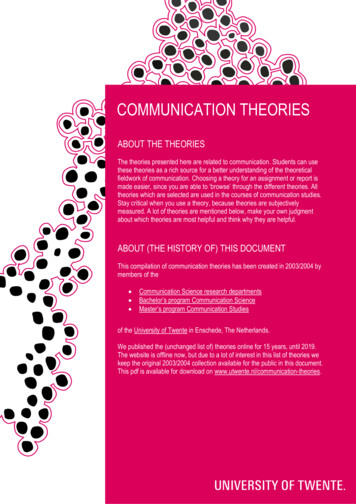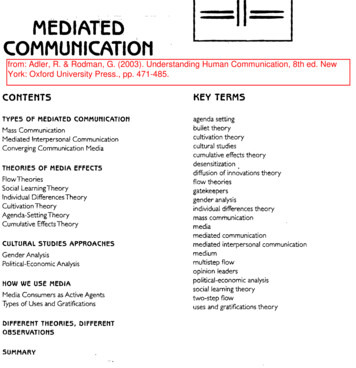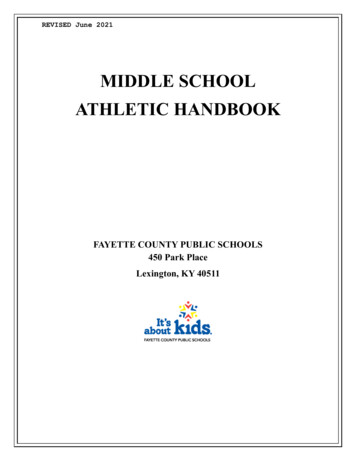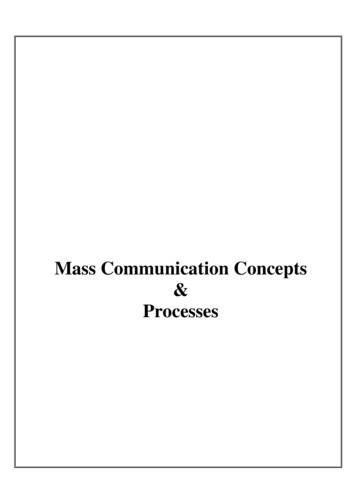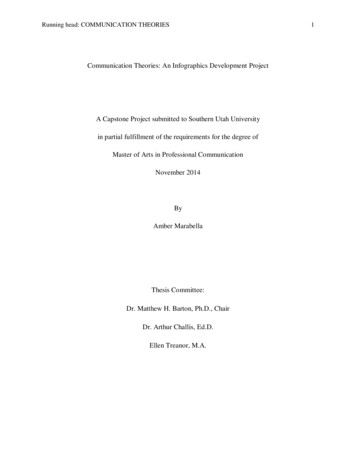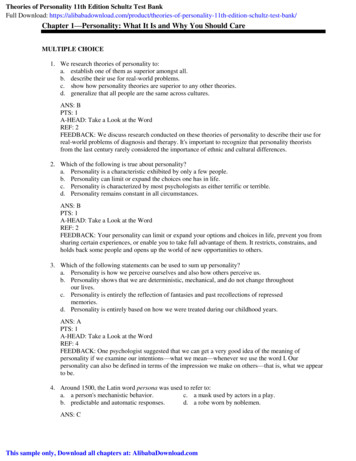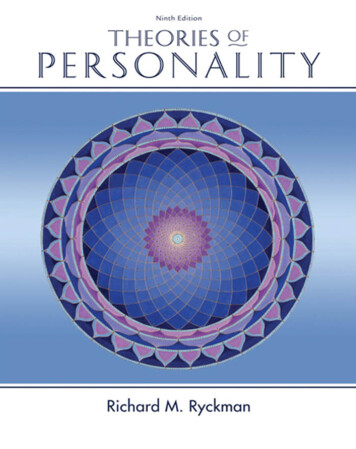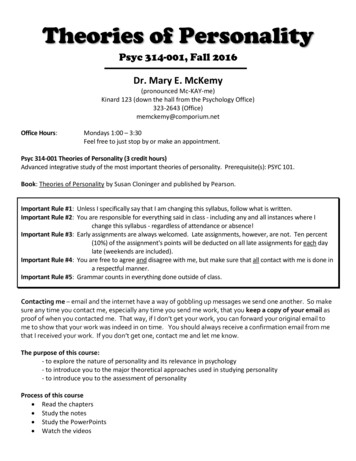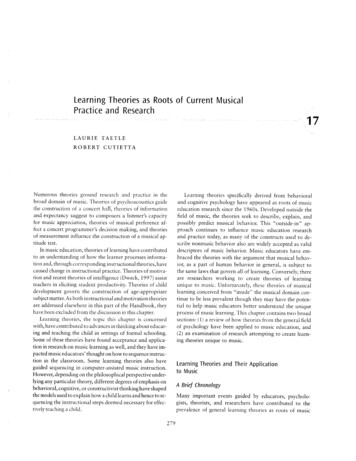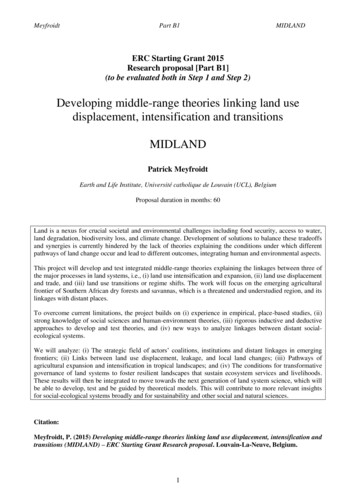
Transcription
MeyfroidtPart B1MIDLANDERC Starting Grant 2015Research proposal [Part B1](to be evaluated both in Step 1 and Step 2)Developing middle-range theories linking land usedisplacement, intensification and transitionsMIDLANDPatrick MeyfroidtEarth and Life Institute, Université catholique de Louvain (UCL), BelgiumProposal duration in months: 60Land is a nexus for crucial societal and environmental challenges including food security, access to water,land degradation, biodiversity loss, and climate change. Development of solutions to balance these tradeoffsand synergies is currently hindered by the lack of theories explaining the conditions under which differentpathways of land change occur and lead to different outcomes, integrating human and environmental aspects.This project will develop and test integrated middle-range theories explaining the linkages between three ofthe major processes in land systems, i.e., (i) land use intensification and expansion, (ii) land use displacementand trade, and (iii) land use transitions or regime shifts. The work will focus on the emerging agriculturalfrontier of Southern African dry forests and savannas, which is a threatened and understudied region, and itslinkages with distant places.To overcome current limitations, the project builds on (i) experience in empirical, place-based studies, (ii)strong knowledge of social sciences and human-environment theories, (iii) rigorous inductive and deductiveapproaches to develop and test theories, and (iv) new ways to analyze linkages between distant socialecological systems.We will analyze: (i) The strategic field of actors’ coalitions, institutions and distant linkages in emergingfrontiers; (ii) Links between land use displacement, leakage, and local land changes; (iii) Pathways ofagricultural expansion and intensification in tropical landscapes; and (iv) The conditions for transformativegovernance of land systems to foster resilient landscapes that sustain ecosystem services and livelihoods.These results will then be integrated to move towards the next generation of land system science, which willbe able to develop, test and be guided by theoretical models. This will contribute to more relevant insightsfor social-ecological systems broadly and for sustainability and other social and natural sciences.Citation:Meyfroidt, P. (2015) Developing middle-range theories linking land use displacement, intensification andtransitions (MIDLAND) – ERC Starting Grant Research proposal. Louvain-La-Neuve, Belgium.1
MeyfroidtPart B1MIDLANDSection a: Extended Synopsis of the scientific proposal (max. 5 pages)A. State-of-the-art and objectivesRationaleTerrestrial ecosystems provide essential resources, including food, feed, fiber, and many other ecosystemservices, and land use is one of the major forces driving global environmental change in the Anthropocene[1]. Human activities on land have directly affected around 100 Mkm2, leaving less than 30% of the ice-freeland surface largely untouched [2]. The land system is thus a nexus for some of the most pressing societaland environmental challenges including food security, access to clean water and air, land degradation,biodiversity loss, and climate change [3]. Developing and implementing solutions to balance these tradeoffsand synergies and achieve sustainable land uses is thus central for human well-being, and requires in-depthunderstanding of complex land systems and land change trajectories. This understanding is the focus of therecently emerged land change science, or land systems science (LSS) [4].After two decades of existence, LSS is now a mature field, which has produced a wealth of methodologicalinnovations, empirical observations, and contextual explanations, in particular through case-studiesdescribing drivers and impacts of land change [5]. Synthesis has been essentially realized through systematicreviews and meta-analyses of the quantitative importance of drivers and impacts of land change, as well as aseries of prominent “box and arrows” frameworks, e.g., on the articulation of proximate and underlyingdrivers [6], social-ecological systems [7], or teleconnections or telecouplings – i.e., linkages between distantsocial-ecological systems [8]. But few theoretical developments have taken place within LSS. The fieldessentially borrows theories from other disciplines, and is largely lacking of middle-range theories – i.e.,contextual generalizations which describe chains of causal mechanisms valid for explaining a relatively wellbounded range of phenomena, and the conditions or contextual factors which trigger, enable or prevent thesecausal chains [9] –, which integrate the different human and environmental aspects of the land system. Thisrelative neglect is repeatedly highlighted as one of the major frontiers in the field [4,5]1, but has not beenconcretely addressed yet. Because of this relative lack of integrated theories in LSS, (i) design of case studiescan hardly be based on theoretically-derived hypotheses to test; (ii) development of process-based simulationmodels is hindered, making it difficult to simulate complex interactions and feedbacks; and (iii) therelevance of LSS for governance remains largely limited to the places where studies were conducted.Building on (i) the methodological strengths of LSS in empirical, place-based studies, (ii) in-depthknowledge of social sciences and human-environment theories, (iii) rigorous approaches to develop and testtheories, and (iv) new approaches to analyze telecouplings, this project will overcome this situation, andmove towards the next generation of land systems science, which will be able to develop, test and be guidedby theoretical models, and thereby generate more relevant insights for social-ecological systems andsustainability science.ObjectivesThe central objective of this project is to develop integrated middle-range theories explaining the linkagesbetween three of the major processes in land systems, i.e., (i) land use intensification and expansion, (ii) landuse displacement and trade, and (iii) land use transitions or regime shifts. This objective will be articulated insteps focusing on different aspects of the emerging land use frontier of Southern African dry forests andsavannas biomes, and its linkages with distant regions.These theories should be able to explain (i) how governance and other dynamics of land use change in oneregion generate leakage and other forms of land use displacement, (ii) how land use displacement isorganized by coalitions of actors to shape land systems regime shifts and frontiers emergence, and (iii) howland use displacement, and broader forms of telecouplings including governance feedbacks, can bechannelled to foster transformative changes towards sustainable land use intensification in land use frontiers.B. Research approachThe project will pull land system science towards a theory-rich field by building on the strengths and roots ofLSS, with its strong focus on empiricism. The project thus will take an inductive approach to theory1 See also Turner II, BL, “Land System Science: Land systems, sustainability and land system architecture”, keynoteaddress at the 2nd Global Land Project Open Science Meeting, Berlin, 19 March 2014. s/BL Turner II2
MeyfroidtPart B1MIDLANDdevelopment, grounded into in-depth empirical studies. Theory development and testing will be based oncombining a typological approach drawing on statistical tools and counterfactuals to establish causal effectsof different combinations of factors, with a process-tracing approach to identify chains of causal mechanismslinking hypothesized variables to outcomes within specific case studies [6]. Analyzing causal chains will alsodraw deductively on existing theories proposing specific, discrete causal mechanisms. Combination of causaleffects and causal mechanisms are indeed necessary to establish convincing causal explanations [10].Theoretical efforts will focus on three core themes: (i) land use intensification versus expansion asalternative paths of land change; (ii) land use displacement, i.e., geographic displacement of land usecorresponding to land embodied in agricultural and forestry products traded; and (iii) land use transitions orregime shifts, i.e., non-linear and structural transformations of land systems, such as forest transitions, whichare shifts from net deforestation to net reforestation. These three processes constitute some of the majorchallenges in transformation towards more sustainable and resilient land systems. With looming scarcity ofland for expansion, sustainable intensification of production systems is increasingly crucial for addressingthe multiple demands for land-based products and services [11,12]. LSS focused originally on place-basedstudies and local causes of land use change, but recently started to acknowledge the growing importance ofdistant causes and indirect consequences of land changes across international borders [13]. Withglobalization, land use displacement and leakage – i.e., land use displacement caused by a policy orintervention to govern land uses –, emerged as major themes. Finally, despite the explicit inclusion offeedbacks and non-linear trajectories in intensification and forest transition theories, the field is still heavilyframed around the notion of “drivers”, focusing on one-way causal relations and linear dynamics, thus hardlyintegrating more complex feedbacks from land changes. Theories have been developed to explain these threetypes of land changes, though leaving important aspects unexplained [11-17]. Further, there is no convincingtheory addressing the linkages between these different dynamics. Current geographic and economic theoriesfocus either on international trade or on local land change processes, rarely linking the two. This project willspecifically work across scales, by analyzing and linking dynamics at local (landscapes), regional, and global(e.g., international trade) scales. Regime shifts theory, as part of the broader resilience theory [18,19], will beused to improve understanding on such systemic interactions and resulting land systems transitions.The proposal focuses on processes of land change and displacement as they condition the emergence anddevelopment of land use frontiers, i.e. areas with abundant land and natural resources relative to labor orcapital, and rapid land use change [20]. Most studies have been focusing on corrective measures in alreadyestablished and active frontiers. Here, we will focus on the initial triggers and investigate a potential frontierat its emergence. The emerging frontier studied is the dry forests and savannas regions of Southern Africa,i.e., including the countries of the Southern African Development Community, such as Mozambique, SouthAfrica, Zambia, Angola, and others [21], although work in other regions will also be conducted to studydistant linkages and allow for comparability and generalizability of the findings. This region is considered asone of the areas concentrating the remaining large-scale pools of potentially available cropland. Agriculturelinked to global markets is still limited in the region but rapidly growing. Distant actors are increasinglymobilized, including through large-scale land acquisitions – or “land grab” –, to overcome constraints onfrontier development [21]. Compared to humid tropics, tropical dry forests and savannas have received littleemphasis in the scientific agenda, government policies and public awareness, despite their rich biodiversityand carbon stocks, and crucial importance for rural livelihoods [22,23]. The novelty of this project is thus toestablish the knowledge for pre-emptive governance of the frontier to foster resilient human-modifiedlandscapes that sustain ecosystem services, biodiversity and livelihoods [24,25].Details and articulation of the specific stepsThe overarching project is articulated in 5 steps, addressing different components of the land system withdistinct perspectives and objectives (Fig. B1.1). Each step will contribute to develop and test theories toexplain specific questions, and together will allow addressing the overarching questions of the project.Focused study areas within the broader Southern Africa region will be selected for the different steps, basedon preliminary investigations of the fit between the specific objectives and the local contexts, as well asopportunities and contacts established. The project will run over five years. After a six months preparationand recruitment period, Step 1 (1 PostDoc for 2 years) and 2 (1 PhD for 4 years) will start in parallel. Step 3(1 PhD for 4 years) will start six months later, to build on contacts and study areas of Project 1. Step 4 (1PostDoc for 2 years) will start on year 3, to build on the achievements of the three previous projects. The lastsix months will be mainly devoted to the synthesis work (end of Step 5). By the design of the proposal and ofthe staff profiles, the team will be interdisciplinary and contributing with complementary skills.3
MeyfroidtPart B1MIDLANDThe steps are strongly complementary. Step 1 on actors' dynamics and strategies, Step 2 on trade flows andland use displacement and their links with aggregate land use, and Step 3 on local pathways of land changewill mutually build on each other. Step 4 will build on the understanding of the strategic field andmotivations of actors, land change processes, and telecouplings, to understand how to improve governance ofland systems and sustainability in the focal region and beyond. This Step will also constitute a tough test toverify that the knowledge and theories generated throughout the project can actually contribute to improvegovernance and transform land systems in the focal region and beyond. Step 5 will draw on the specifictheories developed through the other projects to propose integrated middle-range theories of land systems.This strong integration is central to understand articulations between the different aspects and scales ofsocial-ecological systems, and is thus a major high-gain aspect of the project. Yet, each step can achieve itsspecific objectives in case of failure of one step, and the central goal of developing integrated theories willstill be feasible, although the precise scope and processes explained may have to be re-evaluated.Figure B1.1. Framework of the proposal and articulation of the different steps.Step 1: Actors’ coalitions, institutions and distant linkages in emerging agricultural frontiers(PostDoc). This step will address the following questions: (i) How do distant and local actors form coalitionsto create the conditions for frontiers development, and to compete for land and natural resources; (ii) Whatare the logics that sustain the decisions of key actors, and do they correspond to the factors hypothesized tocondition frontier emergence, e.g. in the resource frontiers theory [20]; and (iii) How do these coalitionsshape possible governance feedbacks resulting from environmental change? The general hypothesis is thatthe patterns of frontier development are shaped by the combination of structural factors and the agency andskills of some key individuals. Using the theory of strategic action fields [26], we will draw on interviews,secondary sources (on monetary flows, projects reports, and others), combined with a mapping ofoverlapping claims and land use competitions on the ground, to understand logics of the actors in relationwith contextual factors. The step will go further than any previous study of telecoupling, by (i) combiningfield surveys in a specific study region, with travels and surveys in the international decision centers of themain actors and sites of origins of the telecouplings, and by (ii) broadening the scope beyond economic andpolitical actors to include multilateral organizations, NGOs, and other private actors.Step 2: Linking land use displacement, leakage, and land changes (PhD). This step will develop and testtheories to explain (i) how do land use dynamics in a source country, in particular different pathways offorest transitions, generate land use displacement and leakage, and (ii) when does land use displacementresult in intensification on already cultivated lands versus expansion of land use. Empirical relations betweenland use displacement and forest transitions or intensification have been shown [27,28], but no theoryadequately explains these patterns. We will articulate operationalizable hypotheses along chains of causalmechanisms, to test claims from multiple competing theories explaining patterns of trade, includingenvironmental Kuznets curve, ecological modernization, pollution haven, ecological unequal exchange,commodity chains, competitive advantage of nations, and land use theories. These hypotheses will first beexplored using cross-country spatial panel analyses and structural equation modelling, with socio-economic,institutional, demographic, cultural, trade, and land use variables. Improved land use variables compared tothe typically used FAO data will consist of various time series of spatially-explicit datasets already available[30] or under development, including by teams at UBC and the University of Minnesota. Then, we will also4
MeyfroidtPart B1MIDLANDuse the SEI-PCS model under development [29], allowing to trace products exported by a country from theirplace of origin (e.g., municipality) to the country of destination, going beyond the current mainstreamcountry-to-country trade analyses. Combined with spatially-explicit data from Step 3, this will allowanalyzing the effects of different patterns of trade on local pathways of land change.Step 3: Pathways of agricultural expansion and intensification in tropical landscapes (PhD). This stepwill develop and test theories explaining, in tropical landscapes and frontier regions, the conditions underwhich increased production of commodity or subsistence crops is achieved through intensification and/orexpansion over different types of land uses/covers, and produces different patterns of indirect land usechange (iLUC). We will go beyond the current focus on aggregate measure of land use/cover change,towards explicit analyses of both sources and sinks of land in change trajectories. This will fix majorknowledge gaps on dry tropics and African landscapes, on the constraints and social and environmental risksof converting potentially available cropland to permanent agriculture, and on the conditions for sustainableintensification in frontier regions. Recent hypotheses on factors controlling pathways of commodity cropexpansion, combining landscape, economic, sociological and political factors [31] will be tested in a set ofcontrasted landscapes in Southern Africa and, for comparison, in humid tropics (Central Africa andSoutheast Asia). Remote sensing data, surveys, secondary statistical sources and spatial statistical analyseswill be combined to measure pathways of expansion and intensification, for different crops and types ofactors, to assess local displacement of land use, or iLUC, and to explain these pathways of land change.Step 4: Transformative co-production of future land systems in frontier regions (PostDoc). Policyrecommendations in LSS typically propose marginal adjustments, rather than transformative changes. Wewill develop a process of land use planning which (i) brings together public and private actors operating atdifferent scales, from global to local, (ii) builds on the recent proposals to integrate LSS with landscapeplanning through “land systems architecture”, (iii) accounts for tradeoffs between local and globalsustainability issues, (iv) integrates emerging private-led and market-based instruments of land usegovernance. Building on the knowledge generated through the other steps, actors identified in Step 1 will beapproached to participate to a series of workshops, supported by mapping, tradeoffs analyses and scenariodevelopment. Various visions of land uses will be explored, including possibilities for sustainable largescale, capitalized commodity crops operations as well as diverse forms of agroecology and smallholderresilient land systems. Positive visions for sustainable intensification will be developed, as well asunderstanding of current barriers. Building on frameworks from resilience science [32], the goal will be tobuild methodological toolboxes and theoretical supports to understand the conditions under which deliberatetransformative changes in land systems governance in the focal region and beyond can be fostered.Step 5: Integrative theory of land use intensification and expansion, land use displacement, andtransitions (Applicant). The applicant will organize, coordinate and directly contribute to the different stepsto (i) lead each of them to achieve their specific objectives, (ii) maximize the synergies in terms of contacts,data collected and processed, and knowledge, and (iii) adjust the articulation of the different steps over timeto ensure that their outputs are complementary. This step will also synthesize the outputs of the other ones, todevelop integrated middle-range theories explaining the linkages between land use intensification andexpansion, land use displacement and trade, and land use transitions or regime shifts.Impacts and expected outcomes. This project will contribute to regenerate LSS, and open doors for newresearch avenues. Theories linking land use intensification, displacement and transitions will be relevant forother contexts and places, by (i) generating testable hypotheses to explore through multiple case studies,taking stock of recent developments to analyze comparability and representativeness of cases, such as theGLOBE tool [33], (ii) feeding land change simulation models with processes to implement, and (iii) showingthe moderating effects of different contexts on governance interventions. We will set up the standards forfuture works in terms of developing contextual theories based on case studies, formulating testablehypotheses and testing them using empirical data. Theories and knowledge more specifically developed onthe focal region will also be useful to understand and more sustainably govern the dynamics of land use inother active or emerging frontiers, and in other regions with land use competition between commodity cropsfor distant markets and smallholder agriculture for local uses. Knowledge generated will also improve therepresentation of the tradeoffs and indirect impacts of climate change mitigation strategies based on land usein Earth system science. Theories developed for land systems could thus strongly contribute to furthertheoretical developments in social-ecological systems in general.Collaborations. The project will be primarily run by the applicant and his team, supported by multiplecollaborations, including with teams of scientists working on land use and development / environment issues5
MeyfroidtPart B1MIDLANDin Southern Africa (e.g. Dr C. Ryan at Edinburgh University), on land use intensity, material flows andinternational trade (e.g., Drs K.-H. Erb and H. Haberl at Alpen-Adria University, Drs G. MacDonald, K.Carlson and others at University of Minnesota), on land changes in various other regions (e.g., Drs T.Kuemmerle and others at Humboldt University in Berlin, N.I. Gasparri at Tucuman University, Y. Le Polainat Stanford University), and on resilience science (teams at Stockholm Resilience Centre). Collaborationswith Earth system and macro-economic modelers (e.g., Dr S. Luyssaert at LSCE and Prof. T. Hertel atPurdue University) will allow to compare the inductive generalizations about global land change dynamicsdrawn from this project with process-based modelling experiments. The goal of pulling LSS towards a moretheory-supported and theory-generating field will also be achieved through broader collaborations andoutreach within that community and related ones, including through the Global Land Project within FutureEarth. Along the course of the project, workshops with external experts in land system and sustainabilityscience will be organized to discuss, improve and if necessary reorient the running of the project.C. Summary of innovative elements. The project will: Take stock on existing specific theories, to develop and test integrated social-ecological systemstheories addressing land use intensification, displacement and transitions.Build on the strengths of LSS in empirical studies, while fixing gaps and establishing a clear precedentfor theory development and testing in LSS, pulling the field to the next generation.Explicitly analyze cross-scale linkages between local, regional and global dynamics.Address breakthrough topics, including pathways of commodity crop expansion in dry biomes inAfrica, conditions of emergence of resource frontiers, and potentially available cropland.Perform truly transdisciplinary research, combining positivist and hermeneutic approaches, andgenerating methods and knowledge to transform governance of social-ecological systems.Be directly linked and relevant to major international networks and communities such as the GlobalLand Project and Future Earth.Provide methodological advances to analyze cross-scale and distant social-ecological linkages,including linking land change and international trade with subnational trade data, and understandingboth local and distant actors’ strategies, and governance feedbacks.D. References.1. Steffen W, et al. 2007. Ambio 36:614–6212. Luyssaert S, et al. 2014. Nat Clim Change 4:389–3933. Foley JA, et al. 2011. Nature 478:337–3424. Turner II BL, et al. 2007. Proc Natl Acad Sci USA104:20666–206715. Lambin EF, Geist HJ, eds. 2006. Land-Use and LandCover Change. Local Processes and Global Impacts.Springer: Berlin6. Geist HJ, Lambin EF. 2002. BioScience 52:143–1507. Ostrom E. 2009. Science 325:419–4228. Liu J, et al. 2013. Ecol Soc 18:269. George AL, Bennett A. 2005. Case Studies and TheoryDevelopment in the Social Sciences. MIT Press:Cambridge, MA.10. Meyfroidt P. Causal effects and causal mechanisms:Approaches and terminology for causal analysis insocial-ecological systems and land system science.Manuscript in preparation.11. Lambin and Meyfroidt 2011 Proc Natl Acad Sci USA108:3465–347212. Kuemmerle TK, et al. 2013. Curr Opin Envir Sustain5:484-49313. Meyfroidt P, et al. 2013. Curr Opin Envir Sustain5:438-44414. Hertel TW, et al. 2014. Proc Natl Acad Sci USA111:13799–1380415. Turner II BL, Ali AMS. 1996. Proc Natl Acad Sci USA93:14984–1499116. Angelsen A. 2010. Proc Natl Acad Sci USA107:19639–1964417. Meyfroidt P, Lambin EF. 2011. Annu Rev Env Resour36:343–37118. Folke C, et al. 2004. Annu Rev Ecol Evol Syst 35:557–58119. Müller D, et al. 2014. Global Environ Chang 28:75–8320. Barbier EB. 2011. Scarcity and Frontiers: howeconomies have developed through natural resourceexploitation. Cambridge University Press: Cambridge,UK.21. Gasparri NI, et al. 2015. Cons Lett, in press22. Parr CL, et al. 2014. Trends Ecol Evol 29:205–21323. Shackleton CM, et al. 2007. For Pol Econ 9:558–57724. Gardner TA, et al. 2009. Ecol Lett 12:561–58225. Hecht SB, et al. (eds). 2014. The social lives of forests:Past, present, and future of woodland resurgence.University of Chicago Press: Chicago.26. Fligstein N, MacAdam D. 2012. A Theory of Fields.Oxford University Press : Oxford, NY.27. Meyfroidt P, et al. 2010. Proc Natl Acad Sci USA107:20917–2092228. Kastner T, et al. 2014 Environ Res Lett 9:03401529. Godar J, et al. 2015. Ecol Econ, in press30. Hansen MC, et al. 2013. Science 342:850–85331. Meyfroidt P, et al. 2014. Environ Res Lett 9:07401232. Moore ML, et al. 2014. Ecol Soc 19:5433. Schmill MD, et al. 2014. In COM.Geo ’14:Proceedings of the 5th International Conference onComputing for Geospatial Research and Applications.Washington, DC6
MeyfroidtPart B2MIDLANDERC Starting Grant 2015Research proposal [Part B2)](not evaluated in Step 1)Part B2: The scientific proposal (max. 15 pages)A. State-of-the-art and objectives1/ State of the artLand and terrestrial ecosystems provide essential resources, including food, feed, fiber, and many otherecosystem services. At the same time, land use is one of the major forces driving global environmentalchange in the Anthropocene [1,2]. Human activities have directly affected around 100 Mkm2 of the ice-freeland surface leaving, as of today, less than 30% of the land surface largely untouched [3]. Of this, between23 and 38 Mkm2 (18-29% of the land surface) has been deliberately converted, mainly by deforestation, foragriculture, infrastructure and urban use, and 55-75 Mkm2 (42-58% of the land surface) have notexperienced land cover conversion but are managed to satisfy human demands. Many land use practicesresult in ecological detriments, including land degradation, biodiversity loss, and climate change. The landsystem is thus a nexus for several of the most pressing societal challenges including food security and accessand availability of clean water and air [4-6]. Developing and implementing solutions to balance thesetradeoffs and achieve sustainable land uses is thus central for human well-being, and requires in-depthunderstanding of complex land systems and land change trajectories.Land change science, or land systems science (LSS), has recently emerged as a part of sustainability science,studying land change and interactions between society and terrestrial ecosystems through land use [7,8]. LSShas been very successful to produce a depth of empirical observations, descriptions and contextualexplanations, mostly through case-studies where both the drivers and impacts of land change are observedand linked in terms of causal relationships [9]. Synthesis of these case-studies has been performed mainly bysystematic reviews and meta-analyses of the frequency of the different drivers and impacts of land change[10,11], and by
development of land use frontiers, i.e. areas with abundant land and natural resources relative to labor or capital, and rapid land use change [20]. Most studies have been focusing on corrective measures in already established and active frontiers. Here, we will focus on the initial triggers and investigate a potential frontier at its emergence.
